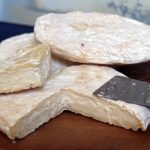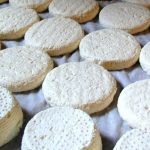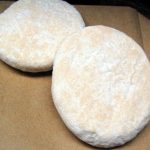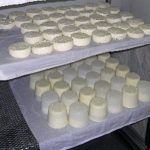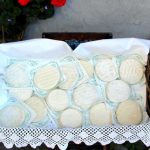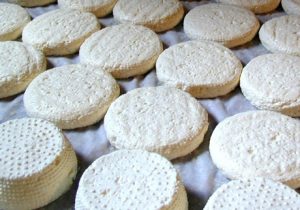
Name
Toumin Dal Mel
Seal of quality
Prodotto Agroalimentare Tradizionale (PAT) / Typical food-farming product. Procedures are in course to obtain PDO status.
Description
This cheese comes in a tapered cylindrical disk-like form with a diameter of between 10 and 12 cm , an extremely convex rim between 1- 2 cm in height: the average weight of one whole cheese varies from 150 to 250 g . When the cheese is fresh, it is practically rindless and is milky white; when it is seasoned, the rind becomes of a porcelain white colour covered with a thin layer of white mould. It is a white fine-textured cheese, sparse eyes and often presents proteolysis phenomena towards the outer part when the cheese is more seasoned.
Its has a sweet flavour, similar to fresh milk, slightly acid and not very salty in the fresh form, whereas the more seasoned forms are more fragrant due to mould development on the rind. The rind can be eaten.
Whole milk from Piedmontese bovine breeds, or their crosses, fed mainly with local forage, is used for the preparation. Small supplements of goat’s milk are possible (not exceeding 10%).
Whole milk is coagulated at a natural coagulating temperature, between 32-35° C within two hours from milking, using limited quantities of calf whey. Mild heat pasteurisation treatment is allowed.
Subsequently, the curd is sharply broken down with a cross cut, then is crumbled down to the size of a hazelnut, in order to favour whey discharge. The curd is then extracted and put into small moulds with holes for further whey discharge. Salting is carried out when the curd is positioned in the moulds, but not excessively in order to maintain the typical flavour of fresh milk. Dry salting can be carried out in brine or covering the top of the cheese with salt.
Seasoning must occur in natural cellars or air-conditioned places where optimal temperatures can be guaranteed. Seasoning is completed on shelves made of natural wood, where the forms are placed on natural fibre cloths that are replaced periodically. The minimum period of seasoning is 4 days, but can extend to 30.
Area of production
The area of production traditionally includes the communes of Melle, Frassino and Valmala. The disciplinary regulations established for PDO status extends the area of production also to the bordering communes of Brossasco, Isasca, Piasco, Rossana, Sampeyre and Venasca.
History
Toumin dal Mel made its first appearance somewhere around the middle-late 19 th century on the medium-high grounds of Valle Varaita, spanning the villages of Frassino and Melle. More recent studies indicate that the real inventors of toumin dal Mel were four village dwellers of the small village “Vitoun” in Frassino, pushed by the necessity to find an alternative to butter, which at that time was the main dairy product and the production of which was too much for the economy of the small valley. The production later spread to the neighbouring communes and the product was sold at the market of Melle, from which it takes its name, Toumin dal Mel. After the Second World War, the Mel market lost its importance and direct sales were replaced by deliveries to shops and delicatessens in the areas of Cuneo and Saluzzo. An important event “La Sagra del Toumin” has been taking place in Melle every year in the month of August since 1974.


